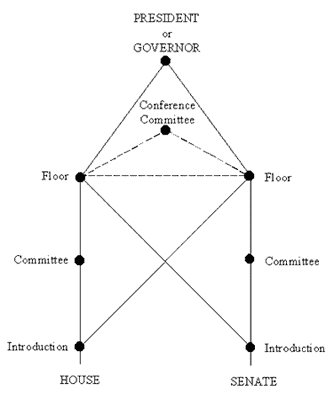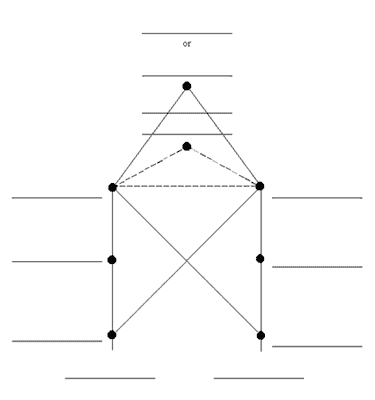-
A bill can be introduced into a legislative branch only by a member of that
branch. For example, only a Senator can introduce a bill into the Senate.
When the President or Governor want a bill passed, they have to find a member
of the legislative branch to introduce it. What is a bill?
-
There are others who also try to find a legislator to introduce a bill in
Congress or the General Assembly. They include lobbyists, pressure groups, and
political action committees (PAC). Complete the matching exercise below.
___ groups of people who attempt to influence the government's action on issues a. lobbyist ___ a group which raises money to influence elections and passage of laws b. pressure group ___ a person who tries to influence the passage or defeat of bills and other government actions c. PAC -
After a bill is introduced, it is assigned to the proper committee. What does
the committee do with a bill?
-
After a bill is approved by committee, where is it sent?
-
What is the purpose of the conference committee?
-
Where does the conference committee send the bill?
-
When a bill finally reaches the President or Governor, there are four
possibilities: 1) the bill is signed, 2) the bill is held for ten days, after
which it becomes law even without a signature, 3) the bill is vetoed, 4) the
bill receives a pocket veto. What is a veto and a pocket veto?
- It is difficult, but possible, to override the veto of a President or Governor. What must Congress and the General Assembly do to override a veto?
-
How can Congress and the General Assembly remove laws?
-
What method can Ohio voters use to remove laws?
-
What is the name of the process by which the U.S. Supreme Court and the Ohio
Supreme Court remove laws?
-
Use the
Glossary
to match the words and definitions:
a. abolish
b. amendment
c. initiative
d. judicial review
e. petition
f. ratify
g. referendum
h. repeal___ to make a formal request and have others sign ___ to take back, to officially make null and void ___ to do away with ___ the power of the Supreme Court to review laws and declare them unconstitutional ___ referring bills or constitutional amendments to voters for approval or rejection ___ a legally adopted addition to or deletion from a law ___ citizens propose a new law or reject an existing law by petitioning the government for referendum ___ to approve -
The law can be changed by constitutional amendment, but it is a difficult two
step process. First, an amendment must be proposed, in one of two ways. Then,
it must be ratified, in one of two ways. Look up amendment in the Glossary and
complete the chart below.
Proposing an Amendment Ratifying an Amendment 1.
1. 2. 2.
|
|
|

|
The Companion to The Little Book On Line
for Teachers and Tutors |
J & K: Making, Amending, and Removing Laws
Learning Outcome #11: Describe the process for making, amending, or removing laws.
Directions, Part A: In the United States the law making process is complex. It is easy to propose a law. However, it is difficult for a bill to become a law. Thousands of bills are introduced to Congress each year. Few become laws. Carefully read and study Section J under Important Things to Remember and Related Words in The Little Book. Then, answer the questions below. Use the Glossary for definitions.
![]()
Directions, Part B: Now that you understand the steps in the law-making process, you need to memorize that process. The diagram below shows the simplest route for a bill to become a law in both our national and state governments. It covers steps 1 to 8 in Section J. Notice the shape you have. It is a rocket with an "X" and a triangle inside! Also, notice that the lines connecting to the conference committee are dashes. The dashes are a reminder that all bills do not go to that committee. Remember, a bill can start in either house, except for tax bills which must start in the House of Representatives.
The purpose of the diagram is to make the law making process easier to memorize. The process is represented by the rocket shape and each step by one word clues. See if you can explain the process of how a bill becomes a law by using the diagram. If you get stuck, turn back to Section J. Then, practice labeling the diagram from memory on the next page.

Without looking back on the last page, write the terms listed below in their correct position in the diagram. Then, using your memory, recreate the entire diagram, including terms, on a blank sheet of paper.

Terms:
|
Committee
Committee Conference Committee Floor |
Floor
Governor House Introduction |
Introduction
President Senate |
If you want additional practice, consider making flash cards and practice arranging them in the proper order.
![]()
Directions, Part C: Laws can be amended or removed through a variety of ways. Carefully read and study Section K under Important Things to Remember and Related Words in The Little Book. Then, answer the questions and complete the chart below.
![]()